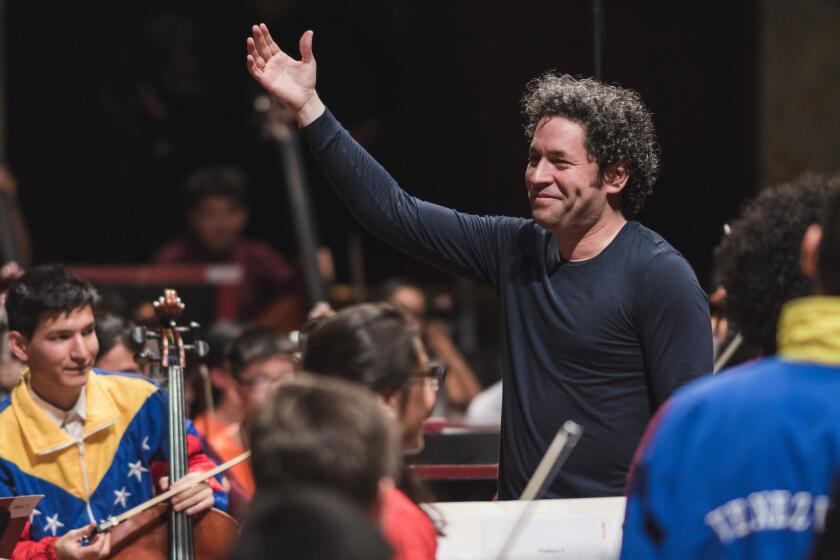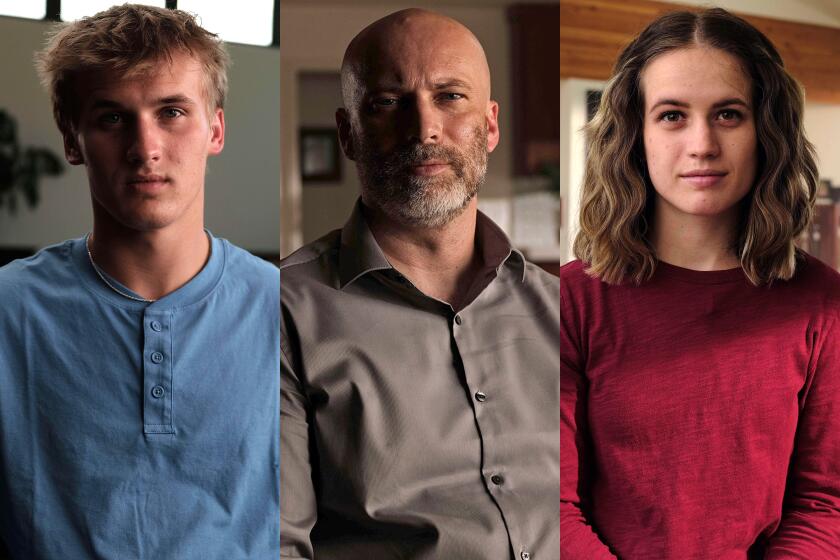A Duet of Chance : Art: World premiere of John Cage’s work for solo violin at UC San Diego will be a collaboration with Mineko Grimmer’s kinetic sculpture.
- Share via
LA JOLLA — When Igor Stravinsky first encountered John Cage’s “4’33”,” a work of total silence, the crusty Russian composer sneered, “I only hope his silences will become longer.”
Railing against composers who employ the element of chance, one of the cardinal tenets in Cage’s musical faith, 20th-Century German composer Paul Hindemith growled, “Chance is one of the ugliest modern musical diseases.”
Already, Cage has outlived his most derisive critics. And the 78-year-old American avant-garde composer continues writing music when a majority of his colleagues have chosen genteel retirement. In his customary contradictory manner, however, Cage denies being driven to compose.
“There really isn’t any inside reason to do it,” he said in a phone interview from his New York City apartment. “There are plenty of sounds without writing any. But people ask you to do things, and I have quite a list of pieces that I’ve agreed to write. I don’t see a period in which I won’t (be composing). For me personally, it’s not important.”
Important or not, Cage is enthusiastic about his creations. On May 22 at 5 p.m., he will attend the premiere of his “One 6” at UC San Diego’s Warren Lecture Hall. The work for solo violin will be performed by UCSD faculty member Janos Negyesy in the presence of Mineko Grimmer’s audible sculpture “Untitled.”
As Negyesy explained, the event is a kind of triple premiere. “One 6” has never been publicly performed; Grimmer’s installation is new, although its similar cousin was displayed last fall in Tokyo. And the combination of Cage and Grimmer is definitely a premiere.
Negyesy, a longtime collaborator with Cage who premiered all of Cage’s virtuoso “Freeman Etudes,” was the catalyst who brought Cage and the Los Angeles-based Grimmer together.
“I first saw the installation (‘Palisade’) by Grimmer in the Mesa College Gallery last year,” Negyesy said. “I was so excited about it that I called Sherman George of the UCSD media center and recorded three of the Cage ‘Freeman Etudes’ standing in the sculpture. I made a copy of the videotape and sent it to Cage.”
In “Palisade,” Grimmer employed her trademark pebbles frozen in a block of ice suspended above bamboo poles and taut piano wires. When the pebbles slowly fall into a pool of water through the bamboo and wires, they create random sounds.
Cage and Negyesy discussed over the phone the merits of combining the “Freeman Etudes” and Grimmer’s “Palisade,” but concluded that the two works are not compatible.
“We decided that both pieces were so strong that they tended to cancel one another out,” Negyesy said.
Cage suggested another violin piece, “One 6,” which he originally composed for his New York conductor-violinist colleague, Paul Zukofsky. The three-movement, 45-minute piece has only long, sustained notes and only a few pitches. Following the composer’s disposition to allow the performer to shape the work, the duration of each note is left up to the performer, although Cage has strictly specified the parameters of beginning and ending each note.
“As a composition, ‘One 6’ avoids gravity. It is just floating,” Negyesy explained, “while Grimmer’s work is directed toward gravity. Those two directions could make a strong unity. Of course, I will have to rehearse with the sculpture to set the most optimal conditions for the timing of the ice melting.”
“We are bringing the two works together,” Cage said, “not in the sense of complementing, but coexisting. They will stand side by side.”
Although the notation of Cage’s work contains no directions relating it to Grimmer’s sculpture, it will be Negyesy’s challenge to shape Cage’s tones to the installation’s movement.
Like “Palisade,” the sculpture Grimmer has constructed for the Cage performance employs her trademark falling pebbles, bamboo rods and piano wires. The design of “Untitled,” however, is different from the shape of “Palisade,” which was encircled by a tall fence.
Followers of Grimmer’s work will not be surprised with the Cage juxtaposition. Critics who have reviewed her “kinetic audible sculptures,” as she calls them, have occasionally invoked Cage’s spirit or influence. In a review of Grimmer’s 1988 installation at the Koplin Gallery in Los Angeles, Times art critic William Wilson observed, “When the pebbles hit (the bamboo wands), there is a newer music of astringent cracks and muffled plops that would bring joy to the heart of John Cage or Philip Glass.”
Like Cage, Grimmer sees chance as an integral facet of her artistic credo.
“I enjoy chance because many of my works are tightly and geometrically crafted. I like the contrast, then, of the random activity of pebbles falling from melting ice,” Grimmer said.
Grimmer said she never consciously felt the influence of Cage’s ideas on her work, although she was aware of his compositions and his work with chance. But she has worked with other composers in performance installations, including percussionist Stephen Schick, now a member of the UCSD music faculty, and Los Angeles computer composer Carl Stone. She has also worked with dancers and members of a No drama theater in Japan.
Both Cage and Grimmer expressed their aesthetic in terms that defy the usual canons of their respective fields.
“I see the whole nature of my work as ephemeral,” Grimmer explained. She said she chose the term ephemeral in contrast to the usual perception of sculpture as substantial, immutable save for the ravages of time. For Cage, the unpredictable element of his music begins with the composer.
“I have no notion of what a composition will be until I hear it. I think most composers in the history of (Western) music have either heard or imagined the work before it takes place. I write to hear something I’ve never heard before.”
Janos Negyesy will perform the premiere of John Cage’s “One 6” at 5 p.m. May 22 at UC San Diego’s Warren Lecture Hall, in accompaniment with Mineko Grimmer’s audible sculpture “Untitled.”
More to Read
The biggest entertainment stories
Get our big stories about Hollywood, film, television, music, arts, culture and more right in your inbox as soon as they publish.
You may occasionally receive promotional content from the Los Angeles Times.










